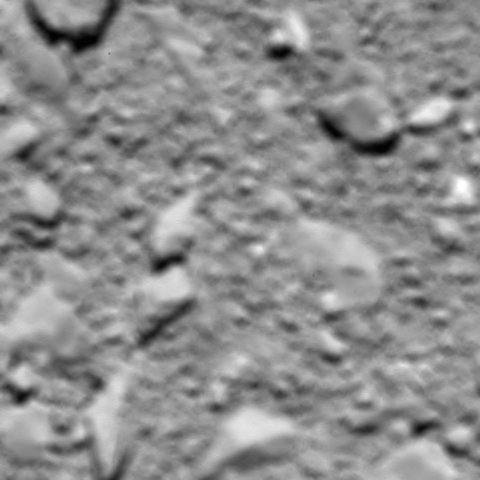UPDATED CAPTION INFO
This is Rosetta’s last image of Comet 67P/Churyumov-Gerasimenko, taken shortly before impact, an estimated 20 m above the surface.
The initially reported 51 m was based on the predicted impact time. Now that this has been confirmed, and following additional information and timeline reconstruction, the estimated distance is now thought to be around 20 metres; analysis is ongoing.

Close-up view of the surface of Comet 67P/C-G imaged with the OSIRIS wide-angle camera, shortly before Rosetta’s final impact on the comet. Credit: ESA/Rosetta/MPS for OSIRIS Team MPS/UPD/LAM/IAA/SSO/INTA/UPM/DASP/IDA
The image was taken with the OSIRIS wide-angle camera on 30 September 2016. The image scale is about 2 mm/pixel and the image measures about 96 cm across.









Discussion: 17 comments
Does the camera need to be refocused for such close images? And was there any ability to refocus the cameras or was the focus fixed before launch?
The focus has essentially been fixed to infinity.
There was also a context WAC image done at 500m or so that Holger Sierks was showing during the media interview. Does anyone know if this is for public sharing yet? I had the impression that they would publish the context with the deconvolved final image with its calculated position on the context, as well as the orientation and position of final impact. I realise a fair bit of work is involved with this, but it is something well worth looking forward to!
David, Here’s a link to an extensive paper on the camera systems.
OSIRIS – The Scientific Camera System Onboard Rosetta
https://pdssbn.astro.umd.edu/holdings/ro-a-osiwac-3-ast1-steinsflyby-v1.4/document/osiris_ssr/osiris_ssr.pdf
fixed focus, good for distances of km to 10^4 km
The NAC was designed to remain in focus down to
1 km above the nucleus surface. (page 12 of cited material)
WAC: No refocusing necessary for distance range 500 m to infinity
Great, great project, something possible only because a group of persons decided it could be done. The best of humanity arises in projects like this, hope to see others from Europe soon.
This 20m view doesn’t look very different from Philae’s “comet from 9 metres” image, and Rolis had better focus. So Agilkia and Ma’at probably have similar territory. Is the Osiris NAC view from 16km (see “Descent images begin”) related to that taken by Osiris NAC from 8km a couple of years ago?
Valuable pic, for now.
Since one pixel of the OSIRIS WAC views 101 µrad, from 20 meters it would correspond to 2 – not 5 – millimeters. And the field of view of this frame would be only 97 centimeters wide. Please check with the OSIRIS team.
Have checked again and indeed it is 2mm/pix and 96 cm.
Apologies for not having the correct information sooner.
Those images are awesome!
Will you post it when the team deconvolutes the image? I am really curious what other details can be figured out here, tried some blind deconvolution tools available on the internet but results were no good.
It looks like my last post didn’t make it through the reCaptcha or the posting mechanism for some reason.
Regarding deconvolution of the image, I found this tweet:
https://mobile.twitter.com/_RomanTkachenko/status/781950915687440385
It seems a bit ‘overdeconvoluted’ to me, there are bright lines along edges and there’s a lot of noise (which might be artifact of compression used on original image) but overall it still looks very nice.
At what distance are now Philae and Rosetta?
Where are the regions of Agilkia and Abydos? https://m.esa.int/Our_Activities/Space_Science/Rosetta/Getting_to_know_Rosetta_s_comet
Dear Luke,
Here is a composite image with Philae’s and Rosetta’s landing sites in context:
https://www.esa.int/spaceinimages/Images/2016/09/Comet_landing_sites_in_context
Best wishes